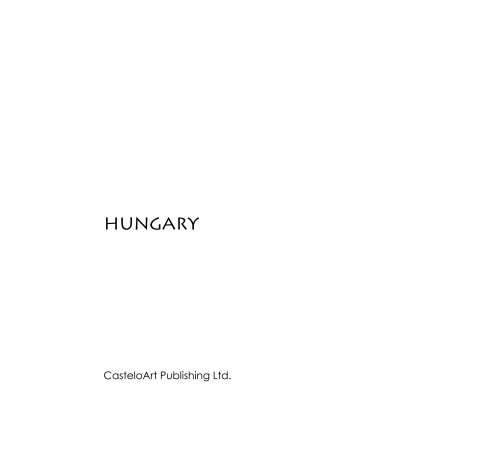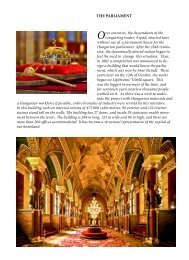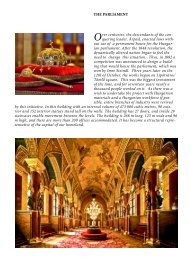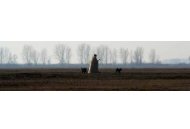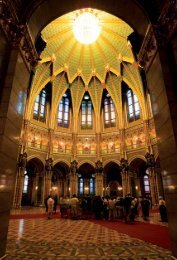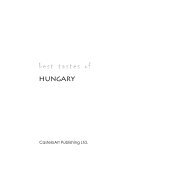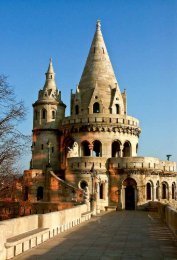HU_traveler_EN
Create successful ePaper yourself
Turn your PDF publications into a flip-book with our unique Google optimized e-Paper software.
<strong>HU</strong>NGARY<br />
CasteloArt Publishing Ltd.
P R E F A C E<br />
As the saying goes, „ a picture is worth a thousand words” and who could think of a better way to appreciate the rich<br />
and ornate thousand year history of Hungary than with such a colorful and beautiful picture book. Through foreign eyes,<br />
Hungary appears to be a mystery at first. A long, somewhat confusing history is exactly what makes Hungary a bit difficult<br />
to understand. However, a strong sense of nationality and traditional values amongst the Hungarian people is and has always<br />
been lavishly expressed in its dazzling architecture - especially that of mid 19th - early 20th century when Hungary flourished
under the Austro-Hungarian Empire. From the capital city of Budapest to the farmlands of Hortobagy, Hungary’s astounding<br />
churches and Basilicas, city halls and parks, castles and fortresses and bathhouses are all visual treasures for the history buff<br />
tourist. More than 90 pages of beautifully colored photos of all the delightful towns and cities of Hungary will not only give<br />
you the memories of an exciting trip abroad, but maybe also help give some insight as to who are and were the „Magyars”.
THE PARLIAM<strong>EN</strong>T<br />
Over centuries the descendants of the conquering leader, Árpád, enacted laws without having a permanent house for the Hungarian<br />
parliament. After the 1848 revolution, the dynamically altered nation began to feel the need for the change of the situation. Thus, in<br />
1882 a competition was announced to design a building that would house the parliament, which was won by Imre Steindl. Three years<br />
later on the 12th of October, the works began on Lipótváros’ Tömlő square.<br />
4
THE PARLIAM<strong>EN</strong>T<br />
This was the biggest investment of the time, and for seventeen years nearly a thousand people worked on it. Standing in the middle<br />
of the great vaulted hall, one can see the northern and the southern lounges on the right and left. The picture depicts the southern<br />
lounge, which used to belong to the Lower House. Passing through the northern lounge, opposite the chamber/hall of the House (it once<br />
was the conference room of the Lower House) in the northern annex, we reach the conference room of the Upper House. This is often<br />
used for housing international conferences.<br />
7
FREEDOM BRIDGE<br />
The bridge was given to the public as a part of the Millenneum celebrations, but its original name was Franz Jozef. It was built<br />
between 1894 and 1896, and the monarch himself hammered in the last nail. During the Second World War-similar to other<br />
bridges of Budapest- it was demolished, but during the city’s rebuilding, it was the first one to be erected again. It became a<br />
national emblem, the symbol of freedom.<br />
8<br />
THE CHAIN BRIDGE. In winter one used to be able to walk on the iced surface of the Danube, but during ice drifts, commuting<br />
in this way between the two banks of the river became impossible. Once, István Széchenyi was forced to wait an entire week in<br />
December of 1820 until he found one brave boatman who would take him to the other side. After this incident, he initiated the building<br />
of “the Bridge” . Building this bridge had historical significance, since it was the first permanent bridge between Pest and Buda.
9
BUDA CASTLE<br />
The history of Buda Castle goes back to the days of old times. The early central palace was severely damaged in the battles against<br />
the Turks, but later thanks to the initiative of Maria Theresa, it was renovated in a majestic baroque style. Unfortunately, the palace<br />
fell victim to the Second World War, and at present it does retain any parts which would reflect the luxury of the bygone days’ kings.<br />
Today, it has an important role in the country’s cultural life since its chambers are used by the Hungarian National Gallery, the National<br />
Széchenyi Library, the Ludwig Museum of Contemporary Art and the Historical Museum of Budapest.<br />
10
11
12
THE FISHERM<strong>EN</strong>’S BASTION<br />
Today’s Halászbástya (the bastion of the fishermen) was built in 1902 in the place of a former fortress. It is on the castle’s<br />
wall, but contrary to its name, it never served the purpose of protection. Its seven towers represent the seven leaders of the<br />
conquering Hungarians. The lookout from these towers is a gorgeous sight.<br />
13
MATTHIAS C<strong>HU</strong>RCH<br />
The former Budavári Nagyboldogasszony templom (the Church of Our Lady) has always been a prominent one in the Hungarian<br />
history. It had been standing for centuries when King Mátyás (“Righteous Matthias”) built a tower on it. Weddings of this grand king<br />
and other great figures of Hungary were held in this church, and the last king to be crowned, Károly I made his oath here as well.<br />
Today, the church is a sacred place of pilgrimage but it is open to the public, and visitors should not miss the musical high masses.<br />
14
15
16
THE VAJDA<strong>HU</strong>NYAD CASTLE<br />
The end of the 19th century brought a special series of events for Hungarians. The nation was celebrating the foundation of the state. The<br />
Millennium Exhibition of 1896 was part of these celebrations. The event resulted in erecting many new buildings. One of them, found in the<br />
Városliget, was this castle with its four different architectural styles designed and carried out by Ignác Alpár. These buildings all display the<br />
stylistic features of other monuments from Hungary’s past which are located elsewhere in the country. After the conclusion of the celebration,<br />
the castle was given to the Museum of Hungarian Agriculture where visitors are always welcome.<br />
17
C<strong>EN</strong>TRAL MARKET HALL<br />
Aiming at ceasing the noisy and dirty outdoor markets, the City Council established the Central Market Hall. The stately neo-gothic<br />
building was handed over to the traders in 1897, and almost at the same time, four other market halls were built on the Pest side.<br />
18
19
20
HEROE’S SQUARE<br />
All the lamp posts are facing a peculiar monument on the Hősök tere (Heroe’s Square). It is the millennial monument which<br />
commemorates the thousandth anniversary of the original settlement of the Hungarians. The monument depicts the heroes who<br />
made Hungarian history with their deeds.<br />
21
SAINT STEPH<strong>EN</strong>’S BASILICA<br />
As the church’s proud castle, this divine monument is the adornment of the Szent István tér (square). Building it was so<br />
important that even the monarch Franz Jozef came to see how the keystone would be set down. The sanctuary is a frequently<br />
visited place by believers, but it is also a popular tourist sight of Budapest. The building itself is astonishing while the view of<br />
the city seen from the cupola is simply unforgettable.<br />
22
23
24
SAINT GELLÉRT HOTEL AND THERMAL BATH<br />
The Szent Gellért Hotel and Bath was opened in 1918. Similar to other places of the early 20th century, this one is also presented<br />
in the secession style. Besides being a well known and popular thermal hotel worldwide, it is also a gorgeous sight.<br />
25
SZ<strong>EN</strong>T<strong>EN</strong>DRE<br />
At the junction of the mountains and the plain land, on the bank of the Danube, lies the city of museums and art, the cultural<br />
paradise of tourists, Szentendre with its more than two thousand years of history. Its museums, galleries, and cozy cafes<br />
can be approached via streets of cobblestone, and through narrow alleyways. Szentendre houses the Open Air Museum of<br />
Ethnography, which presents folk architecture, and the life of Hungary’s most characteristic regions.<br />
26
27
VISEGRÁD<br />
This picturesque town which celebrated its millennium last year was the capital of Hungary under King Charles Robert. The construction<br />
of the Upper Castle was initiated by the wife of King Béla IV, Queen Mary in the 1250’s, and later it was enlarged by King Sigismund and<br />
King Matthias.The Tower named Solomon is situated on the hillside beneath the castle. A fortified military camp once stood here, where<br />
King Solomon was held between 1081-1083 at the command of King Saint Ladislaus. Visegrád and the Upper Castle are now tourist
attractions. The town attracts thousands of tourists from in- and outside of Hungary annually because there are great opportunities for<br />
excursions, visiting historic monuments, reliving the past, and taking pleasure in the beautiful sight of the Danube Bend. Visegrád has<br />
also hosted the popular summer palace games for several decades ; a unique spectacle in the country. The games are staged in the<br />
in the dress of the times of King Matthias’. In the programme spectacular jousts are performed and the visitor can even try archery.
30
ESZTERGOM<br />
Grand Prince Géza chose Esztergom as his kingdom in 972, making it the first capital of our country. King Saint Stephen was<br />
crowned here on 1 January 1001; he founded the archdiocese of Esztergom as the centre of the Hungarian church. The Basilica<br />
of Esztergom, the largest church in Hungary, was built on the castle hill. This masterpiece was consecrated in 1869, and for that<br />
occasion Franz Liszt composed his Esztergom Mass.<br />
31
SZÉKESFEHÉRVÁR<br />
Székesfehérvár was a settlement of Chief Árpád’s tribe in the time of the Settlement of the Magyars in the Carpathian Basin.<br />
It was later the coronation, wedding and burial centre for kings for centuries. In 1222, it was the place of the announcement<br />
of the Golden Bull (Aranybulla). Numerous beautiful and interesting sights await the visitor. A stroll through the streets of<br />
the city centre are a like travel back in time, evoke atmosphere of the past.<br />
32
33
34
TATA<br />
Tata was given its name nearly a thousand years ago. In the time of the Grand Prince Géza, the future ruler, Vajk used to call his monk<br />
teacher Tata. The teacher was given this land in return for proividing educational services and he later founded a Benedictine monastery<br />
here, named after him. It was always a popular place as the nearby forests were unsparing in game and the waters abound with fish. In<br />
1397 a fortress was built on the bank of the Old Lake, which, however, never served protective purposes. It was in fact built as a hunting<br />
castle, as a place of entertainment for kings. When József Esterházy later took over the leading of the fortress, he made several changes.<br />
He had the moors drained and had mills built on the streams. Miklós Esterházy had a castle built on the bank of the lake by Jakab Fellner,<br />
near the fortress. Ferenc I emperor and king, and his wife found refuge here for several weeks fleeing from the Napoleon wars, and it was<br />
here that the ruler signed the Vienna Peace Treaty in 1809 which ended the war. Tata is rich also in natural resources. The visitor today<br />
can take pleasure not only in the extant treasures of past times, but also in the current beauty of nature.<br />
35
VESZPRÉM<br />
This city with county rights, boasting a nearly thousand-year-old history, is situated on the slopes of the Bakony highlands.<br />
It is also called the city of queens due to the privilege of the Veszprém bishop as the only one who was entitled to crown a<br />
Hungarian queen. Today the landscape of the city, which keeps its traditions and preserves its cultural rarities, is dominated<br />
by Baroque buildings that attract tourists with their beauty.<br />
36
37
38
LAKE BALATON<br />
Lake Balaton is the largest lake in Central Europe and it is often referred to as the ’Hungarian sea’. Tourists from within Hungary and<br />
abroad enjoy visiting the lake thanks to the numerous recreation activities offered, including bathing and swimming. Kayak, windsurfing,<br />
water-skiing, fishing and sailing enthusiasts also share the water. For those who are more adventurous, there is the adventure park of Lake<br />
Balaton. The towns and villages surrounding the lake also offer many interesting sights and activities for visitors. In some towns there are<br />
spa baths and thermal springs to the great pleasure of those hoping to find cure. In the hills of the northern side of the lake, in the Balaton<br />
Uplands one will find the home of renowned wine growers, who offer, famous and delicious wines. After sunset when the beaches clear,<br />
the reflection of night lights billow on the surface of the water. This is the time when restaurants, cafes, bars, and nightclubs become alive.<br />
39
TIHANY<br />
Tihany is the only peninsula on Lake Balaton and it is unique in its historical and natural richness. King Andrew I (András)<br />
in the 11th century had the burial place for his family and a monastery built here. He brought Benedictine monks into the<br />
monastery. The best-known sight and symbol of Tihany today is the abbey church, which has been standing since 1752.<br />
40
41
42
LILLAFÜRED<br />
Lillafüred was founded in 1892 in the valley of the Stream Szinva, which belongs to the city of Miskolc. Its pearl is the Palace Hotel<br />
on the bank of the Hámori Lake. This highland resort offers the opportunity for excursions such as cave hikes, boating on the lake<br />
where visitors can enjoy fresh trout.<br />
43
KESZTHELY<br />
Keszthely is one of the most populous and frequented towns of Lake Balaton, situated in the north-western corner of the lake.<br />
It is a cultural centre rich in traditions as well as a university town. Christopher (Kristóf) Festetics set to build his pompous<br />
castle here in the mid 1700’s. Today it can be visited as a castle museum and it houses the oldest and one of the most<br />
beautiful libraries in the country.<br />
44
45
46
HÉVÍZ<br />
The history of Hévíz spa and the therapeutic effects of the lake were already known to the Romans, but the earliest written reference<br />
dates from 1328. The development and revival of bathing in Hévíz is linked with the name of Count György Festetics, who purposefully<br />
built up the bathing resort. Its popularly has grown so much that today several hundred thousands of tourists visit the place every<br />
year, which provides opportunity for comfortable relaxation not only for those looking for healing, but for anyone at all. Besides the<br />
baths, visits to promenades, parks, wine bars, churches and statue parks can make a trip here more colourful.<br />
47
GYŐR<br />
A significant castle had stood here by the time the settler Magyars arrived. In 1009, King Saint Stephen chose Győr as one<br />
of the ten bishoprics he founded , and one part of the quartered body of the pagan Koppány was put out here. Today it is<br />
known for its waters, museums, beautifully renovated Baroque buildings and palaces that can be accessed via the narrow<br />
surrounding streets.<br />
48
49
PANNONHALMA<br />
Pannonhalma is situated some kilometres away from Győr, and is famous for its Benedictine Archabbey. The abbey was founded<br />
in the time of the Settlement of the Magyars in the Carpathian Basin as Grand Prince Géza invited the first missionary monks in<br />
996. The town can be found at the foot of the Benedictine abbey and its history goes back to the Roman times. Although the<br />
50
town was destroyed by the Turks, in the 18th century people once again began to inhabit and rebuild it. Its name was changed<br />
to Pannonhalma in 1965, and in 2000 it was given town status. Besides the sight of the Archabbey, the surrounding mountains<br />
offer great opportunities for bicycle and walking tours.<br />
51
52
FERTŐD<br />
Fertőd is situated in the vicinity of the Fertő-Hansági National Park and Lake Fertő. It came into being through the merger of the settlements Süttör<br />
and Eszterháza in 1950. The Esterházy family took possession of Süttör in 1681. The town is proud to present to visitors, the Esterházy Castle built<br />
in 1720. The castle is a hunting-seat and gained its form known today in 1766 thanks to Nikolaus (Miklós) Esterházy. His contemporaries rightfully<br />
called Nikolaus ’the Magnificent’ or pomp-loving, and this is evident through the design of this amazing Rococo palace and its surroundings. The<br />
cour d’honneur is decorated with fountains, the garden is decorated with sculptures and vases, and in its rooms golden motifs flitter everywhere.<br />
Nikolaus the Magnificent fascinated his visitors not only with his pompous castle, but also with his high-level art life. Joseph Haydn arrived at the<br />
castle to work as a music teacher and spent nearly half of his creative years here, he composed several of his works in this castle.<br />
53
NAGYC<strong>EN</strong>K<br />
Nagycenk is situated in the region of Fertő, some kilometres away from Sopron. Count György Széchenyi purchased the Cenk<br />
estate in the year of the Szatmári accord, which brought peace to the Hungarian nobles. A small house existed on the estate,<br />
which was enlarged. By the end of the 18th century, the castle was a multi-storey building with a balcony on the main façade.<br />
After 1820 Count István Széchenyi became the lord of the castle, and became interested in the opportunities of the future. It is<br />
because of him that the Chain Bridge (Lánchíd) on the Danube was built, the Hungarian Academy of Sciences was founded, and<br />
that numerous revolutionary innovations took place in the life of the Hungarians. From the castle a 2.6-km-long poplar avenue<br />
leads to the tomb of Béla Széchenyi and his wife, which together with the castle became part of the World Heritage in 2003.<br />
54
55
56
SOPRON<br />
The written mention of this town comes from 859. Sopron was a popular residence of noble families, the memory of which is<br />
preserved in the Esterházy Palace, the Széchenyi Palace, and others as well. The town successfully resisted the Tatars, Turks, the<br />
Kuruc movements and the battles of the 1848 revolution and war of independence. Thus there are many medieval churches and<br />
houses standing in the town today. The symbol of the town is the Fire-tower (Tűztorony) built in 1676.<br />
57
KAPOSVÁR<br />
The history of Kaposvár began in 1061 when Atha, a reeve in Somogy, founded a Benedictine monastery here. It had gone<br />
through such great development by 1749 that it became the county town, and in 1993 it was already an episcopal seat when<br />
the parish church of the Assumption was granted cathedral rank. The town is a centre of cultural programmes today and it<br />
boasts an excellent spa bath as well.<br />
58
59
HER<strong>EN</strong>D PORCELAIN<br />
Founded in 1826, the Herend Porcelain Manufactory really started to flourish under Mór Fischer in 1839. In 1842 it was awarded the<br />
Imperial royal porcelain title, then in 1843 won the gold medal in the 1843 national exhibition. At this time porcelain was called white<br />
gold, because it represented great wealth and was a privilege to own. Queen Victoria ordered a floral pattern Herend dinnerware for<br />
the 1851 world fair, and this pattern, called the “Victoria” pattern, has been well-known ever since. One recognition followed another,<br />
as a result of which Mór Fischer received a title of nobility. Currently the owners are in large part its workers, and one quarter is<br />
owned by the state. Among manufactories, it was the first to win the Hungarian Heritage title. The extensive range of the beautiful<br />
handmade products is shown by the fact that there are nearly 16,000 pieces. There is strong demand for the unique, high-end<br />
porcelain, and a testament to this is the fact that Herend Porcelain is available in 50 countries around the world.<br />
61
PÉCS<br />
The city of Pécs, at the foot of the mountain Mecsek, was founded by the Romans in the 2nd century AD. After the Settlement<br />
of the Magyars in the Carpathian Basin in 1009, King Saint Stephen chose the settlement as one of ten bishoprics he founded.<br />
In the place of today’s cathedral, there was a chapel standing in the 4th century, which was rebuilt several times, gaining its<br />
present form as a result. The 4th century building of the Early Christian Mausoleum is an unparalleled sight of the city. The<br />
Early Christian necropolis is part of the World Heritage.<br />
62
63
64
From the 18th century the city saw great development, and to acknowledge this, Queen Maria Theresa declared it a<br />
free royal town in 1780. In the 1850’s and 1860’s factories of nationwide fame were established in the city, which still<br />
function today. Pécs with its unique past is a cultural centre today. Numerous beautiful and interesting sights await the visitor.<br />
Wonderful buildings, houses with Zsolnay-roofs and foliage ornaments, interesting museums all welcome those wishing to<br />
see this pearl with their own eyes.<br />
65
MOHÁCS<br />
66<br />
Mohács, situated on the Danube-bank near Pécs, was one of the independent settlements of the settler Magyars. The<br />
name of Mohács is interwoven with a sad and mournful event in Hungarian history: the Hungarians were defeated on 29<br />
August 1526 in a battle against the Turks by the armies of Sultan Suleiman near the town, and in the battle the king was<br />
also killed. In commemoration of his death, a memorial column was erected in 1867 in the place of the battle. This battle<br />
survives in history as the ’Mohács Disaster’. Later, Germans from the Rhineland and Southern Slavs settled here. Half of<br />
the town’s population is non-Hungarian today.
67
68<br />
T<br />
he most spectacular buildings of the town today bear the marks of Baroque style. The interesting oriental-Hungarian<br />
style Town Hall building was finished in the early 20th century. Besides the beautiful buildings, churches, and<br />
memorials, visitors can also witness an operating water-mill.
The Busójárás (’Busó-walking’) organized every sping in the Carnival season is visited by thousands of people, and is now<br />
on the UNESCO list of Intangible Cultural Heritage.<br />
69
70
KECSKEMÉT<br />
Kecskemét as a town with county rights plays a significant role in the economic and cultural life of the country. Its community is<br />
characterized by strong cohesion, a base created by grape-growing. Although it has been mentioned as a town since the 14th<br />
century, the buildings determining the picture of the town today were built in the time of the millennium. The Cifrapalota (Gaud<br />
Palace), the House of Science and Technology, and the stately building of the Town Hall were built by then.<br />
71
KISKŐRÖS<br />
Kiskőrös is situated on the hills emerging from an area that used to be a moorland. Due to the invasion of the Tatars in the 13th<br />
century, Kiskőrös saw its population shrink as did other similar settlements in the Great Plain. However, thanks to King Béla IV,<br />
the settlement and its surroundings were populated again through relocation of inhabitantes here after the Tatars departed . The<br />
settlement was rather short-lived as in 1529 it was destroyed again, this time by the march-through of the Turkish armies. Kiskőrös’<br />
revival began after 1691 when Leopold I (I. Lipót) bestowed the land upon Paul (Pál) Wattay, and it later came to belong to John<br />
(János) and Stephen (István) Wattay. They decided to populate Kiskőrös again, with Slovakian serfs from the Uplands in 1718.<br />
According to record, Hungarian, Jewish and Roman settlers also appeared afterwards. This town in the Danube-Tisza Interfluve<br />
with its interesting and eventful history is worth visiting today for several reasons. It is famous for its healthy thermal water, cozy<br />
restaurants where abundant meals are served , as well as its museums and country houses, including the birth-house of Sándor<br />
Petőfi--the poet of the people-- and monuments of the famous persons who translated his poems in its garden.<br />
72
73
74
KALOCSA<br />
The town of Kalocsa is as old as the Hungarian state and was one of the archbishoprics founded by King Saint Stephen in 1009.<br />
Kalocsa is the second archbishopric in the country. The Cathedral beside the compelling building of the Archbishop’s Palace<br />
gained its present form in 1754. Today the town is the centre of national paprika growing and production; its history can be<br />
explored in the Hungarian Red Pepper Museum.<br />
75
SZEGED<br />
This beautiful city on the bank of the Tisza has a significant economic and cultural past. Its first written mention comes from<br />
1183. In 1879 the settlement was washed away by the great Tisza flood, but it was rebuilt in three years with unbelievable<br />
dynamism allowing it to became a modern city. The most important museums of the city offer numerous interesting sights:<br />
the Móra Ferenc Museum, the Paprika Museum and the Castle Museum. The most characteristic building of the city is the<br />
Votive Chrurch of Our Lady of Hungary (Fogadalmi templom or Dóm). The buildings around the Church house university<br />
institutions, the Theological Academy and the episcopal cathedral operate therein . The Szeged Open-Air Festival, the most<br />
important cultural programme of Szeged, has been organized in the city for 80 years.<br />
76
77
78
HORTOBÁGY<br />
The and largest park in Hungary was designated a national park in 1973. It features the largest grassland in Central Europe,<br />
and is part of the World Heritage. Hortobágy is the perfect plain developed from the planation of the River Tisza, which<br />
preserves its character even today. The ancient Hungarian Grey Cattle, the managalica swine, and the Hungarian herd-dogs:<br />
the puli and pumi are held here with the purpose of gene preservation.<br />
79
HORTOBÁGY<br />
The symbol of the National Park is the famous Nine-holed Bridge, which was the longest public road bridge in 1833 when it<br />
was finished. The herds of the Debrecen cattle merchants traveled to Vienna using this bridge in the times of the Tisza floods.<br />
Its unique flora and fauna, the endless horizon are a genuine spectacle and great experience for those who like harmony<br />
and nature itself.<br />
80
81
82
KARCAG<br />
Karcag is the capital of the Nagykunság. Its history goes back to the 8th century, when the Cumans from the Kipchak branch of the Asian<br />
Turkic peoples settled here. They became Hungarian, but they have preserved certain elements of their ancient language and culture to<br />
the present day. The town has a significant art life and it is famous for its pottery. Kossuth prize winner Sándor Kántor lived and worked<br />
here, Munkácsy prize winning sculptor Sándor Györfi works in the town, whose outdoor statutes set up in many public squares are to<br />
the praise of his handiwork.<br />
83
DEBREC<strong>EN</strong><br />
Debrecen, also called the civic city (cívis város), is the largest and most significant city of the Trans-Tisza region. At the same<br />
time it is the cultural, intellectual, economic, tourist and transport centre of Eastern Hungary. In 1361, Debrecen was granted<br />
the status of market town, and in 1683, it was elevated to free royal town status. Its name was known all over the continent<br />
thanks to its famous markets and protestant school which was considered excellent even to European standards. Debrecen<br />
was deemed the capital of Hungary twice in history, from 1848-1849 and in 1944. The Great Calvinist Church (Nagytemplom)<br />
is the most characteristic building of Debrecen, and with its ground-space of 1,500 square metres, it is the largest Calvinist<br />
church in Hungary. A church has stood in the place where it stands currently since the Middle Ages, and three of them were<br />
subsequently damaged by fire. Building of the present church was completed in 1824; its height is some 61 metres.<br />
84
85
NYÍREGYHÁZA<br />
Nyíregyháza is a county seat with a population of nearly 120,000, bordering three countries. The first written mention of<br />
the city comes from 1209, although it was known as Nyír at the time. The second half of its name originated in 1236 when<br />
the church (egyház) of the settlement was built. The excellence of its population is shown by the fact that in the 1800’s<br />
Nyíregyháza became free from its feudal landlords, the Károlyi and Dessewffy families, and in 1837 the city was granted royal<br />
86
privilege. From that time on, the city developed quickly. Schools were established, a new town hall and a hospital were built,<br />
and the nearby Sóstó (”salty lake”) Thermal Bath also started to flourish . In 1990, it became a city with county rights. Today<br />
it is the second most significant city of the Northern Plain region. The inhabitants of Nyíregyháza are trying hard to preserve<br />
the tranquillity, humanity and hospitality longed for in addition to the dynamic development.<br />
87
88
MISKOLC<br />
Miskolc, the third largest city of Hungary, was granted town status in 1365. Erzsébet Bath and the Cave Bath in Miskolctapolca<br />
are popular resorts. The foundations of the castle in Diósgyőr were already standing in the 13th century. The castle houses<br />
the Castle Games twice a year where jousts and other performances are held evoking reminders of the Middle Ages.<br />
89
TOKAJ<br />
According to the written sources, Tokaj was a vine-growing region in 1067. In 1823 Ferenc Kölcsey includes the wine region of<br />
Tokaj in his poem – …Tokaj szőlővesszein Nektárt csepegtettél… (…You were trickling Nectar on the vines of Tokaj…) – , the<br />
poem which later became the national anthem of Hungary. This charming historic city which has been attracting tourists for<br />
decades is now part of the World Heritage.<br />
90
91
92
HOLLÓKŐ<br />
Hollókő is the only village in Hungary which is a World Heritage site. This tradition- preserving village with a total of 380<br />
residents is not in operation as a museum or a skanzen, but it is a living village, where functional handicraft workshops are to be<br />
found in the depths of the whitewashed houses with verandas. The families in the friendly, welcoming guesthouses invite visitors<br />
to their tables, where they can find out what real Palóc soup and rösti taste like. The village is surrounded by the picturesque<br />
Hollókő Landscape Protection Area, which offers numerous opportunities for relaxation and excursions.<br />
93
4 - 25 Budapest 26 Szentendre 28 Visegrád<br />
30 Esztergom 32 Székesfehérvár<br />
36 Veszprém 38 -41 Balaton<br />
28<br />
42 Lillafüred 44 Keszthely<br />
56<br />
54<br />
52<br />
48<br />
34<br />
30<br />
140<br />
26<br />
50<br />
4-25<br />
46 Hévíz 48 Győr<br />
60<br />
32<br />
46<br />
38-41<br />
44<br />
50 Pannonhalma 52 Fertőd<br />
72<br />
74<br />
58<br />
54 Nagycenk 56 Sopron<br />
34 Tata<br />
62-65<br />
66-69
58 Kaposvár 60 Herend<br />
42<br />
88<br />
90<br />
86<br />
62 - 65 Pécs 66-69 Mohács<br />
92<br />
84<br />
70 Kecskemét 72 Kiskőrös<br />
78-81<br />
54<br />
82<br />
74 Kalocsa 76 Szeged<br />
70<br />
78-81 Hortobágy 82 Karcag<br />
84 Debrecen<br />
76<br />
86 Nyíregyháza 88 Miskolc<br />
90 Tokaj<br />
92 Hollókő
István Hajni photographer<br />
Published by CasteloArt Ltd.<br />
www.casteloart.hu<br />
Text copyright © Ildikó Kolozsvári<br />
Photographs copyright © István Hajni, p47 Ivanhoe p66,67<br />
p75 Magyar Fűszerpaprika Múzeum , p92, 93 Zoltan B. p45 Ágnes Hatvani<br />
István Hajni would like to thank the following who have helped<br />
directly in making this book: Ottó István Hajni, Chris Tutunzis<br />
Designed and edited by<br />
Bear Books Publishing,<br />
István Hajni<br />
ISBN 978-615-5148-74-3<br />
Printed in China<br />
All rights reserved. No Parts of this publication may be<br />
reproduced in any form without the prior written consent<br />
of the publisher.


